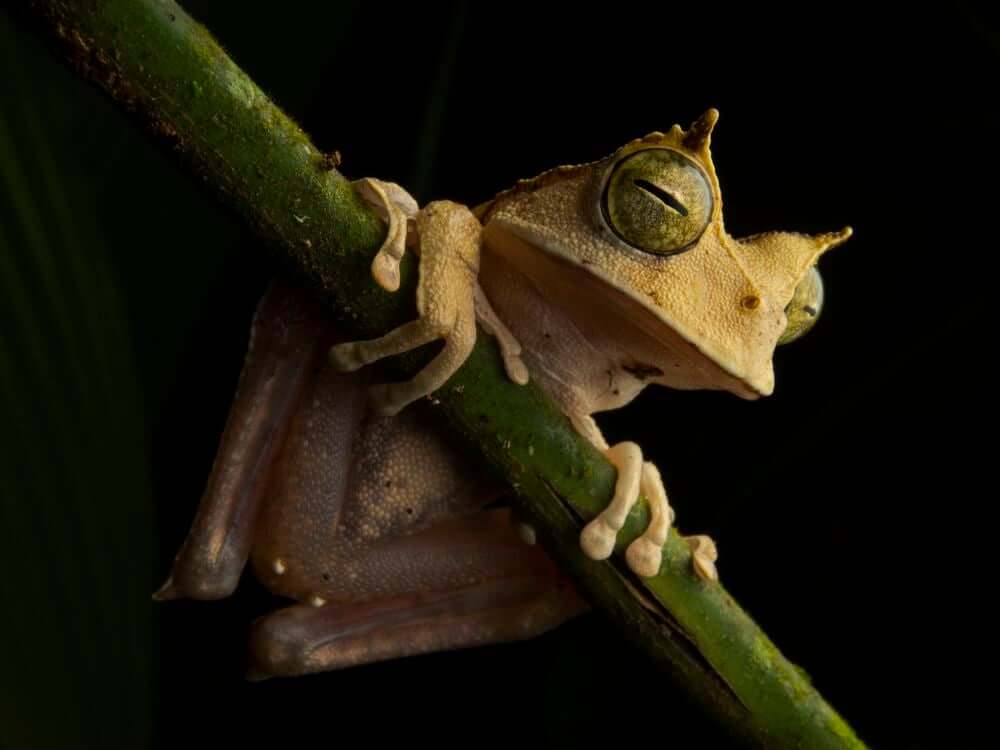
The Surprise Reappearance of A Rare Frog Has Scientists Leaping To Protect Its Habitat
The marsupial frog, which incubates its young in a pouch on its back, was thought to be extinct in some countries
By: Danna Staaf | Smithsonian
The word “marsupial” typically evokes a kangaroo or perhaps a koala, something furry and warm-blooded that protects its babies in a pouch.
“But a surprising variety of creatures have evolved this unusual means of parental care, including crustaceans, seahorses—and frogs.”
With jaunty peaks sticking up from its eyelids that may help it camouflage as a dry leaf, the horned marsupial frog is “a fascinating creature that people can’t wrap their heads around,” says James Muchmore, founder of Save the Chocó, a conservation group dedicated to protecting this threatened region of Ecuadorean rainforest. Instead of laying thousands of eggs in water, like most frogs, female horned marsupial frogs produce only ten or fewer of the largest amphibian eggs in the world, at a whopping diameter of one centimetre. Males then fertilize these eggs and place them into a pouch on the mother’s back, which is what earns the species, and dozens of related frogs, the “marsupial” moniker.
As the embryos grow, they develop structures similar to mammalian placentas through which their mother delivers oxygen, water and possibly nutrients. After about two months, horned marsupial frog eggs hatch as forest-ready froglets, skipping the tadpole stage. This remarkable adaptation frees them from the need to find ponds or streams for egg-laying. They spend their lives high in the trees of Central and South American rainforests, where the humid air is thought to keep their skin from drying out.
Since the second half of the 20th century, however, these forests have been devastated by logging and plantation clearing, a threat exacerbated in the 1990s by a global panzootic (a non-human pandemic) caused by chytrid fungus. For decades, the horned marsupial frog, which once ranged from Costa Rica south to Ecuador, was feared extinct in both countries, surviving only as endangered populations in Panama and parts of Colombia.
But Costa Rican herpetologist Stanley Salazar still searched the forest for remote areas similar to known Panamanian frog habitats. One evening in 2013, he says, “I heard the frog call I’d been hoping to hear for the past three years—like popping the cork from a bottle.” He cut a path toward the call with his machete, then turned off his flashlight. “When it sang, it was right in front of me,” he says. “I turned on the light and saw it. In that moment I was incredibly excited.”
Scientists Collect First RNA From An Extinct Tasmanian Tiger
Then, in Ecuador, in 2018, researchers headed to a little-studied region of the Chocó that narrowly escaped destruction after the non-profit Jocotoco Foundation partnered with Muchmore to purchase land threatened by logging. They returned with joyous news: They’d seen—and heard—horned marsupial frogs. “It’s extremely loud for such a little animal,” says Muchmore, who later visited the area. “You could hear them throughout the jungle.”
The frog’s rediscovery, says Martin Schaefer, CEO of Jocotoco, proves the importance of protecting remote, vulnerable habitats. “Hope is something we all can create with our actions,” he says.
* * *
NEXT UP!
Scientists Find Out If A Lashing Dinosaur Tail Could Generate A Sonic Boom
Every once in a while, scientists embark on a study to test some weird and wacky hypothesis that makes you wonder why. But let’s indulge them; it can be fun
A new study from a team of palaeontologists and aerospace engineers has simulated a dinosaur‘s tail as it lashes about, all to see whether long-necked sauropods could whip their appendages faster than the speed of sound – quick enough to produce the crack of a small, supersonic boom.
Previous research has suggested the dinos could, if their tails had a bullwhip-like structure adding length. If that were true, these herbivorous dinosaurs might have used their tails to defend themselves against predators or nosy neighbours.
* * *
READ MORE: A Dinosaur Killed On The Day of The Fatal Asteroid May Have Been Discovered
Interesting! Giant ‘Death Shadow’ Dinosaur Found In Argentina Is Largest Megaraptor On Record
Enjoyed it? Please take a moment to show your support for Collective Spark.
We’d love to hear from you! If you have a comment about this article or if you have a tip for a future Collective Spark Story please let us know below in the comment section.
